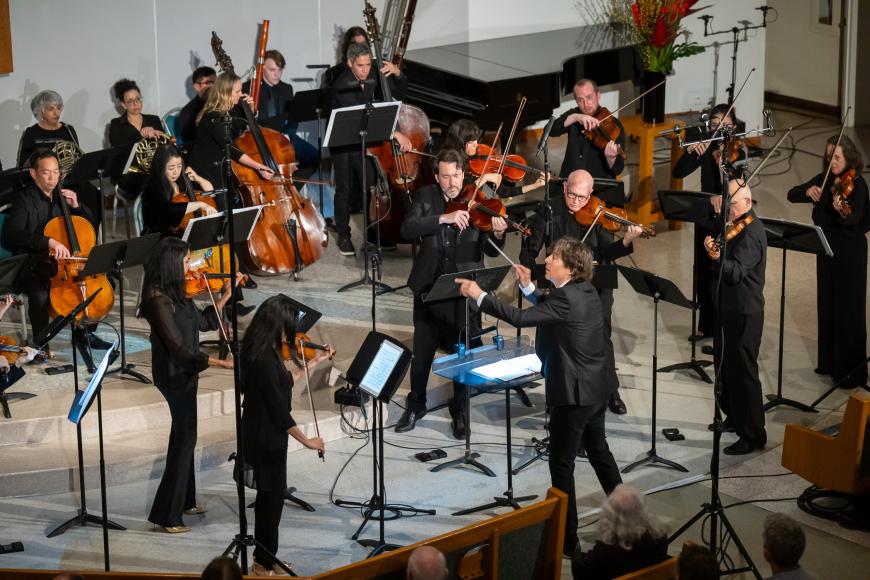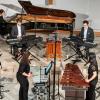
Jacaranda, the maverick Santa Monica music series whose home base is a block away from the edge of the North American continent, is no more. Felled in midseason after a bit more than 20 years on the boards.
The reasons are not a surprise — rising union costs, a deficit that couldn’t be tamed. Co-founder/artistic director/prolific program annotator Patrick Scott hinted that “there will be something next” but can’t say what or when. In the meantime, we are left to mourn the loss of one of the more imaginative alternative music series in Southern California, one that was in the middle of celebrating the influence of Arnold Schoenberg (1874-1951) during his 150th birthday year.
Unlike many organizations that pull the plug with no time for goodbyes, Jacaranda gave us fair warning in advance that it would be folding its tent. And rather than slink quietly off the scene, it went out Sunday afternoon and evening (Feb. 25) with a three-part concert “Fierce Beauty,” which hammered together some at-first-glance unlikely juxtapositions of material, forming a sprawling yet somehow coherent and fascinating whole. A dinner break and an intermission separated the segments. All told, the lingering farewell took about six hours to run its course.
Schoenberg was the guiding star of the event; he provided a good deal of the music and the connections to other music. There was even a deepfake on hand, an AI-generated “video” of Schoenberg eulogizing his L.A. friend and tennis partner, George Gershwin. It was simultaneously an amazing and ominous demonstration of the-future-is-now world that Jacaranda is leaving behind.

In the “old-school” acoustical instrument department, pianist Steven Vanhauwaert opened the marathon with the tumbling dodecaphonics of Schoenberg’s Five Pieces, Op. 23, followed by Pierre Boulez’s more aggressive extrapolation of the Schoenberg method in his Notations — appropriately 12 in number. The pianist then turned to the rolling, roaring, dissonant Suicide In An Airplane by Leo Ornstein (surely the longest-lived composer of all time, having made it to age 109), exploiting the dynamics of the Steinway and obliterating all in its path. Incredible music for 1921.
All of this was a prelude to a live performance of — would-you-believe — John Coltrane’s A Love Supreme as arranged by Miguel de la Cerna and Kahil El’Zabar for a nonet consisting of a string trio, cello, trumpet, baritone sax, improvising tenor sax, piano, and drums. A Love Supreme has become the signature Coltrane work and a symbol of jazz in mass culture; if you walk into a Wal-Mart or Target, it’s likely that the only jazz albums you will see on display are Miles Davis’s Kind Of Blue, Vince Guaraldi’s A Charlie Brown Christmas, and A Love Supreme.
The absorbing program notes strenuously tried to tie the great jazzman to the great composer, detailing Coltrane’s studies in Philadelphia with Schoenberg pupil Dennis Sandole and in that city’s Ornstein School of Music, which Leo Ornstein co-founded. Coltrane’s probings into atonality in the 1960s also can be compared with the path that Schoenberg forged in the 1910s and 1920s. Connecting the dots is something Jacaranda has done really well over the years, and this was one of the most elaborate attempts.

There were problems in getting this Trane on the track. The string trio — which should have been miked — was entrusted with tracing Coltrane’s tunes and improvisations in unison, almost note-for-note, and they sounded as if they were struggling with the difficult, asymmetrical lines. Cellist Ishmael Ali ably played Jimmy Garrison’s bass lines, while Cerna on piano and El’Zabar on drums did their takes on McCoy Tyner’s and Elvin Jones’s parts, respectively; the trumpet and baritone sax players didn’t have much to do. Yet the performance came alive when tenor saxophonist David Murray — a distinguished jazz veteran with a huge discography and a yen for the outer limits — offered burning-on-the-outside improvised responses to the string trio and helped bring the final part, “Psalm,” to a deeply meditative close.
After the dinner break came another out-of-left-field choice, a reduction in length and means of Richard Strauss’s orchestral tone poem Till Eulenspiegel’s Merry Pranks for violin, horn, bassoon, clarinet, and bass. But this clever, gloriously well-played Franz Hasenöhrl transcription worked just fine, boiling the piece down to its essence. The connection here — and why not? — was in the spirit of Schoenberg’s own reductions of other composers’ works.
There was more Schoenberg to come, the centerpiece being a performance of the Chamber Symphony No. 1, led by Mark Alan Hilt, that started tentatively but got stronger and more fervent as it went, with plenty of transparent detail revealed in the resonant First Presbyterian Church of Santa Monica. There were two brief surprise cameo appearances by two eminent local pianists — Inna Faliks playing up a storm in one of Schoenberg’s Op. 11 piano pieces and Gloria Cheng offering a quiet, introspective selection from Op. 19 — and the charismatic young pianist Andreas Apostolou tore into the Gigue from the Suite for Piano, Op. 25.
Leonard Rosenman, a Schoenberg student who made his mark in Hollywood, was represented by his music from Rebel Without A Cause and East Of Eden, attractive, eclectic mélanges ranging from melodic lines with jazz harmonies to atonal ventures, as arranged for piano and skillfully played by Scott Dunn. Violinist Movses Pogossian, whose Dilijan Chamber Music Series has apparently disappeared into the COVID void, got a solo showcase with a slow, searching, introspective rendition of J.S. Bach’s Chaconne, from the Partita in D Minor.

Finally, the farewell gesture — the Adagio from the Tenth Symphony of Schoenberg’s friend and influencer Gustav Mahler, in Hans Stadlmair’s chamber orchestra arrangement, with Dunn taking the baton. The fast-paced performance seemed to float, the rescoring very clear, with ample bass. The big, dissonant climactic chord amounted to a final primal scream of protest on the demise of this concert series, followed by the strings going gently, gently into the night.
With that thoughtful touch, Jacaranda passed into history. For now?




